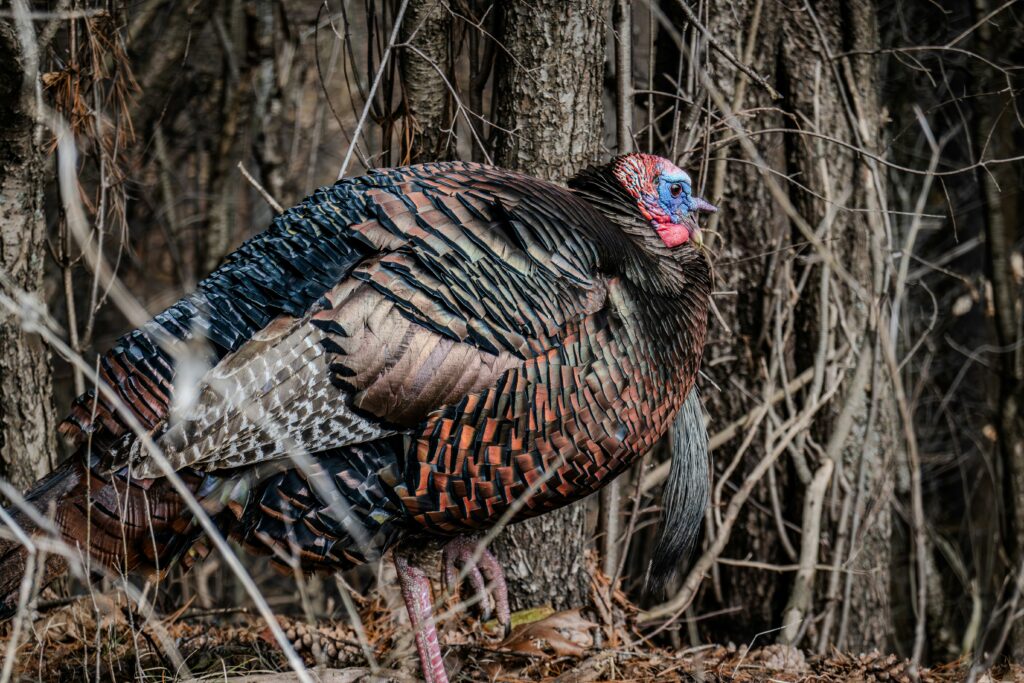You’re here because you’re either curious about turkey hunting or tired of hearing your buddies brag about it. Maybe you’re feeling that primal urge to connect with nature, or maybe you just want some damn good wild-caught protein on your table. Whatever the reason, I’m going to shoot you straight on how to turkey hunt. No fluff, no BS, just the essential information you need to get started.
And before you click away thinking this is too hard, let me tell you something: If I can do it, anyone can be successful too.
The Real Appeal of Turkey Hunting (It’s Not Just the Bird)
Forget the romanticized images. How to turkey hunt effectively requires more than just luck. As you start turkey hunting for beginners its more about smarts and knowing the birds behaviors.
- The Challenge: Outsmarting an animal with eyesight sharper than your grandma’s criticism. Turkeys are smart.
- The Peace: Getting away from the noise, the notifications, and the endless demands on your time. Solitude in the woods is a powerful medicine.
- The Reward: A sense of accomplishment that you just can’t get from clicking a mouse. Harvesting your own food is deeply satisfying.
- The Meat: Let’s be honest, the organic, free-range meat is a huge bonus. Skip the grocery store bird and enjoy some real flavor.
Turkey Hunting for Beginners: The Ground Rules
Think of this as Turkey Hunting 101. Here’s what you need to know before you even step foot in the woods.
- Safety First, Always: This isn’t a video game. Guns are dangerous. Take a hunter safety course. Know your target. Treat every firearm with respect. Period.
- Regulations are King: Ignore the rules, pay the fines (or worse). Check your state’s turkey hunting season dates and regulations. Licenses and tags are mandatory.
- Scouting is Non-Negotiable: Don’t just show up and hope for the best. Find out where the turkeys are before you hunt. Look for tracks, droppings, and feathers. Use an owl call to roost the turkey the evening before. Chances are he will still be there in the morning and that gives you a head start. Listen for gobbles at dawn.
- Patience is Your Secret Weapon: Turkey hunting is about waiting. And waiting. And waiting some more. If you can’t sit still, find a different hobby.
The Gear You Need (and What You Can Skip)
Don’t fall for the marketing hype. You don’t need to spend a fortune to be successful. Here’s the essential gear you absolutely need:
- Shotgun: A 12-gauge or 20-gauge is ideal. Don’t overspend on a fancy model. Reliability is key. I recommend the Mossberg 500. (Why? Because it gets the job done without breaking the bank.)
- Ammunition: Turkey loads. Heavy shot. Experiment with different brands and shot sizes to see what patterns best in your shotgun. Don’t cheap out on ammo. It makes a difference. Federal ammunition is what I use and recommend.
- Camouflage Clothing: Head to toe. Blend in with your surroundings. Don’t wear bright colors. Your visibility can make or break the hunt. I personally swear by Tidewe. They have value without the big price tag. (Pro Tip: Match your camo to your hunting location.)
- Turkey Calls: Slate, box, and diaphragm calls. Learn how to use them all. Turkeys are finicky. What gets their attention today might scare them tomorrow. Practice, practice, practice. More on this later. Primos calls are hard to beat, in my opinion.
- Decoys: Hen decoys are a good starting point. A jake decoy can be effective too, but use it with caution. Placement is crucial. Create a realistic setup. Decoys are vital to draw the turkey to your location.
- Hunting Vest or Pack: To carry your gear comfortably. Pockets for calls, ammo, and other essentials. A built-in seat is a lifesaver. I’ve used the Tidewe vest for years.
- Knife: For field dressing your bird. A sharp, reliable knife is essential.
- First-Aid Kit: Don’t be an idiot. Be prepared for minor injuries.
Optional, But Helpful Gear:
- Binoculars: To scout from a distance.
- Rangefinder: To accurately judge distances. (Essential for ethical shots.)
- Blind: If you’re hunting in an open area or with a group.
- GPS or Smartphone with Mapping App: To navigate in the woods.
Don’t waste your money on:
- Expensive Gadgets: Forget the high-tech gizmos. Focus on the fundamentals.
- Overly Elaborate Camo Patterns: As long as you are concealed, you’re good.
What to Wear Turkey Hunting: Comfort and Concealment
The right what to wear turkey hunting isn’t about fashion, it’s about survival and success. Here’s the breakdown:
- Base Layers: Moisture-wicking fabrics to keep you dry and comfortable.
- Outer Layers: Camouflage clothing that matches your environment.
- Boots: Waterproof and comfortable. You’ll be doing a lot of walking.
- Gloves: Camouflage gloves to conceal your hands.
- Face Mask or Head Net: Essential for breaking up your silhouette.
- Hat: Camouflage hat to complete your disguise.
Turkey Calling Tips: From Squeaks to Seduction
Turkey calling tips is what separates the men from the boys. You can have all the gear in the world, but if you can’t call, you won’t get a bird.
- Master the Basics: Learn to make a convincing yelp, cluck, putt, and purr. There are tons of YouTube tutorials. Watch them. Practice.
- Listen to Real Turkeys: Spend time in the woods listening to wild turkeys. Pay attention to their vocalizations and how they use them.
- Don’t Overcall: Less is often more. Let the turkey come to you.
- Read the Turkey’s Response: Adjust your calling based on how the turkey reacts. If he’s coming in hot, don’t call at all. If he’s hesitant, try a soft purr.
- Learn to “Cut”: A sharp, excited call that can trigger a tom’s curiosity.
- Vary Your Calls: Change your calling sequence and cadence to sound more realistic. Don’t be a robot.
The Turkey Hunting Guide: Your Road Map to Success
This turkey hunting guide will take you from clueless to competent.
- Scout Your Hunting Area: Find out where the turkeys are roosting, feeding, and strutting.
- Set Up Strategically: Choose a location that offers good visibility and concealment.
- Place Your Decoys: Create a realistic setup that will attract turkeys.
- Call Sparingly and Effectively: Use the right calls at the right time.
- Be Patient and Persistent: Don’t give up easily. Turkey hunting requires perseverance.
- Know Your Shotgun’s Range: Pattern your shotgun and know your maximum effective range. Don’t take unethical shots.
- Be Ethical and Respectful: Follow all hunting regulations and treat the land and wildlife with respect.
How to Turkey Hunt: A Step-by-Step Breakdown
Here’s the process in detail.
- Wake up before dawn. It sucks, but it’s necessary.
- Get to your hunting spot before sunrise. Turkeys are most active early in the morning.
- Set up near a roosting area. Listen for gobbles.
- Make a few soft yelps to let the turkey know you’re there.
- Wait for the turkey to fly down.
- Call sparingly as the turkey approaches.
- Be ready for a shot.
- Identify your target clearly before you shoot. Don’t shoot at movement.
- Aim for the head or neck.
- If you harvest a turkey, field dress it and take it home.
Turkey Hunting Season: When to Go
Knowing the turkey hunting season dates in your state is crucial. The dates vary by state, so check your local regulations.
- Early Season: Turkeys are often more vocal and responsive.
- Mid-Season: Hens are starting to nest, and toms are more aggressive.
- Late Season: Turkeys can be call-shy and pressured.
My Personal Turkey Hunting Story (and What I Learned)
I remember the first day I ever stepped foot in the turkey woods. My daddy and I roosted a bird the evening before in a tree just across the pond on our family farm. I remember the hair standing up on my arm when daddy made the owl hoot with just his mouth, that tom let out a gobble that could be heard a mile away. I tossed and turned all night. Finally, when it was time to go, I almost ran to the truck, because all I could think about was that bird coming down from the roost before we could get there. We slipped through the woods in the dark and set up about 100 yards from the tree where we left him the evening before. Daylight was just starting to break when we heard him fly down. My heart was jumping out my chest. Daddy made a couple laps on the slate and he immediately gobbled about 50 yards deeper in the timber than the tree he left. So, we jumped up and made a move and swung around to cut him off before he got too far away. We set up on a knoll and set out some decoys hoping he would head our way before he found some hens. A couple more laps on the slate we could he him coming out of the bottom. I almost couldn’t breathe I was so nervous. A few minutes later we could see him pop his head up out of the bottom then back down. I could hear him scratching around just out of sight. We called again and could hear him coming up the ridge to our right. He came to 40 yards but there was a tree between he and I. It seemed like 30 minutes went by but probably more like 3 minutes, then he gave me the shot. I still remember my daddy telling me to breathe and squeeze the trigger when I was ready, but I better hurry up because he was getting closer. It was felt like slow motion as I pulled the trigger. The next thing I know I was in full sprint towards the bird. It flopped 3 times and didn’t move. You couldn’t wipe the smile off of my daddy’s face nor mine. I learned quick that there is no other greater chess match in the outdoors than the one between you and a longbird. I can’t remember what it weighed or how long the beard or spurs were but I never forgot the feeling that morning.
Ready to Get Started?
Turkey hunting isn’t easy, but it’s incredibly rewarding. Follow this guide, invest in the right gear (using my affiliate links, of course!), and get out there and experience the thrill of the hunt.
Don’t let another year go by while you sit on the couch watching other people live their lives. Take action. Get out there.
Now, before you go, tell me in the comments: What’s the biggest obstacle holding you back from trying turkey hunting? I read every comment and I’ll do my best to help you overcome it.

